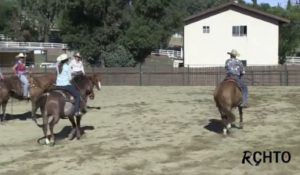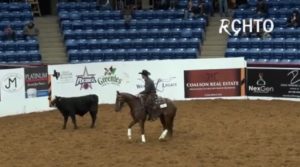
Russel Dilday giving a boxing clinic
You could say going down the fence in reined cow horses is the hero event of the sport. Like bull riding at a rodeo, it’s what the crowd most wants to see. But chasing down a cow at breakneck speed and turning them on a dime can feel like you’re on a collision course and can end in disaster. It’s a daunting prospect for many, especially beginners.
To make the sport more accessible to riders, the NRCHA created a boxing class (or a Non-Pro Limited class) for members who did not want to go down the fence or needed to develop some skills before competing in that high-speed event.
NRCHA President, Corey Cushing, said “[Boxing] is about controlling the cow, but doing it in the right form.”
“It allows the exhibitors a chance to get into the pen. There are a lot of fast moves and different ways to set up your cow. It’s basically the introduction of going down the fence. It gives the rider a chance to go and control that cow and help create turns in the middle third of the arena. That requires driving the cow, stopping the cow, putting yourself in a more controlling situation…” said Cushing.
Hall of Fame trainer Todd Crawford said boxing has actually been around for approximately 30 years. While it started out as a stepping stone for going down the fence, so many people ended up choosing to just box that it became a stand-alone class.
Hall of Fame trainer Lyn Anderson was on the NRCHA Board of Directors when the concept of boxing was developed.
“What we had…was called the Buckaroo class. They did a rein work pattern and then they worked out of the herd and that was [hard]. It was at the end of the day and the cattle were horrible, they’d run through everyone and there were three trainers still there to help. I remember, distinctly, in a board meeting someone saying why are we training people to be cutters instead of reined cow horse people? Why don’t we teach them to box a cow?” she said.
Anderson said boxing today is much better than what it was early on. Over the years a time limit was added and judging criteria was improved.
Crawford agreed that boxing has evolved.
“We had a money limit on the boxing class. If you won $7,500, you had shown your proficiency in boxing and you were forced to move out of the boxing class and into the fence work,” Crawford said.
“We found out that there were people who were boxing, and very successfully boxing, that had no desire to go down the fence…so with that $7,500 limit they were out and they were out of our cow horse industry and moved onto cutting or reining because we had no place for them.”
“There was no criteria to how it was scored. Along with the 50 second time limit, the judging has evolved. There’s a judges card and penalties and credits. It’s a much more consistently judged event,” said Crawford.
Another top trainer, Russell Dilday explained the initial problems with the judging.
“In the beginning, the judge would watch you and when he thought he’d seen enough, he would blow the whistle. It was kind of terrible because the judge could blow the whistle if he thought you were going to lose a cow and save you or hold the whistle until it ran over you and not save you. One judge would say the whistle can’t save you and the next would say we have to use the whistle to keep people from losing,” Dilday said.
Many people complained about the inconsistent judging so the time limit was introduced. Dilday said it made the event fairer and gave the judging more credibility.
Dilday said he and Jay McLaughlin were tasked with determining the time limit riders would box for.
“We sat down and watched a [class] and timed about how long you boxed on the end [before going down the fence] which was generally about 30 seconds, which wasn’t long enough to make a difference. When the cattle start trying you, you need to be able to hold them. And a minute, a minute and a half was too long. Cattle just got sour and no good. Fifty seconds was just the best time we came up…It made them hold it long enough that they could prove they could hold it,” he said.
The boxing class is judged similarly to the fence work but degree of difficulty is more important here than in the fence work.
“I feel the degree of difficulty weighs a little more in boxing. There are a lot of times where the cows don’t want to leave the end and won’t push on you. In order to have any degree of difficulty, you have to step in there…” he explained.
Boxing didn’t just grow the membership of reined cow horses, it also bolstered the horse market.
“Boxing has exploded the sport. Because it gave a place to go with the older, nice horses that maybe aren’t World Greatest horses, but they’re really broke and gentle. It’s a place to sell them and it let a lot of people [in] that couldn’t go down the fence but want to have fun at the show…It put a ton of value in our horses by letting there be more people to compete,” said Dilday.
Dilday gave an example of a cow horse show club in California that would get 7-10 boxing class entries. He put on a cheap clinic at his ranch and enlisted some other trainers to help. They expected a handful of people to come and ended up having 60 people show up to the clinic.
Some of the clinic participants were true beginners, a rider even showed up with his bridle on backwards, Dilday said. At the next show, the boxing class had 70 plus entries.
“[They] are beginners. They don’t need an open horse. It gave a place for us to sell horses and it put a ton of horses in training and people into lessons. It was all around good,” said Dilday.

Trapping the cow at an event
Boxing springboarded Laura Campbell from Clovis, CA off to a great start. She was the Non-Pro Limited Futurity Reserve Champion at the National Stock Horse Futurity in 2017, she won the 2017 Non-Pro Limited Futurity at the Reno Snaffle Bit Futurity and she was also Reserve Champion the following year at the 2018 NRCHA Snaffle Bit Futurity.
She believes that boxing is a great introduction to reined cow horses. Campbell said it helps you learn to read and move cattle and to ride with your feet. She also thinks it’s not as hard on the young horses. She said boxing gave her the confidence to go down the fence.
“…I bought a horse who was in the bridle to learn, then wanted to try an LAE (limited aged event) horse. After two Non-Pro Limited Futurity horses, I had won about $8,000 and decided it was time to show down the fence…The regular Non-Pro classes are very competitive and I would have probably quit if I stepped right into them,” said Campbell.
Another competitor Shelly Mitchell said, at aged 60, the boxing class is the perfect fit for her. “…2021 will be my third year showing a futurity horse, and my fifth year showing a derby horse. I’m hooked.”
NRCHA’s youngest million dollar earner, Kelby Phillips, said in the last few years that entries have gone way up.
Crawford and Phillips agree that going down the fence is hard even for experienced professionals like themselves. Phillips said boxing gives newcomers a chance to be competitive and grow into the sport.
Not only that, there’s a newer class called box-drive-box-drive to bridge the jump between boxing and the cow work. The class requires riders to box the cow at one end, drive it down the fence, box it at the other end and then drive it back down the fence.
He said these classes give reined cow horses an advantage over other performance horse disciplines. You can’t do an ‘easier’ version of cutting or reining, Phillips said.
“[Going down the fence] is so hard because you have to make so many decisions so fast. It takes time to learn how to do it. If they know how to run a reining pattern and want to work a cow, they can jump right in and learn how to box. It’s a stepping stone for them.”
“[Boxing] has brought more customers to the open trainers because [the customers] want to buy a bridle horse to do boxing on, in a few years they’ll want to learn how to go down the fence. So they will want something they can go do that with,” said Phillips.
“No one has a show without boxing anymore!” Dilday said.
Click Here to Watch Russell Dilday’s Boxing Clinic Video!
Article Brought to You By: Myristol
